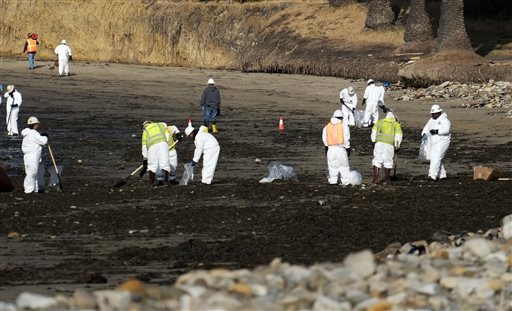
Clean up crews remove oil-laden sand on the beach at Refugio State Beach, site of an oil spill, north of Goleta, Calif., Wednesday, May 20, 2015. AP
GOLETA, California—An oil spill that fouled beaches and threatened wildlife along a scenic stretch of the California coast spread across 9 miles (14 kilometers) of ocean Wednesday as cleanup efforts began and federal regulators investigated how the pipeline leaked.
Workers in protective suits raked and shoveled stinky black goo off the beaches, while boats towed booms into place to corral the two slicks off the Santa Barbara coast where a much larger spill in 1969 — the largest in US waters at the time — is credited with giving rise to the American environmental movement.
Up to 105,000 gallons (400,000 liters) spilled from an onshore pipe and a fifth of that — 21,000 gallons (80,000 liters) — reached the sea, according to estimates provided by officials.
Crude was flowing through the pipe at 84,000 gallons an hour when the leak was detected Tuesday. It took three hours to shut down, though company officials didn’t say how long it leaked before it was discovered or discuss the rate at which oil escaped.
Federal regulators from the Department of Transportation, which oversees oil pipeline safety, investigated the leak’s cause, the pipe’s condition and the potential regulatory violations.
Kristen Karnes, left, and Eric Simon, air monitors with the Center for Toxicology and Environmental Health, take readings in front of oil-covered rocks at the site of an oil spill at Refugio State Beach, north of Goleta, Calif., Wednesday, May 20, 2015. AP
The 24-inch (60-centimeter) pipe built in 1991 had no previous problems and was thoroughly inspected in 2012, according to Plains All American Pipeline LP, which owns the pipe. The pipe underwent similar tests about two weeks ago, though the results had not been analyzed yet.
“Plains is taking responsibility and paying for everything associated with this spill,” said Darren Palmer, a district manager with the company.
There was no estimate on the cost of the cleanup or how long it might take.
A combination of soiled beaches and pungent stench of petroleum caused state parks officials to close Refugio State Beach and El Capitan State Beach, both popular campgrounds west of Santa Barbara, over the Memorial Day weekend.
Still, tourists were drawn to pull off the Pacific Coast Highway to eye the disaster from overlooking bluffs.
Environmental damage was anticipated, but dead fish and oily birds had not been found in the calm seas or rocky coast by late morning, said Capt. Mark Crossland of the state Department of Fish and Wildlife.
The department closed fishing and shellfish harvesting for a mile east and west of Refugio beach and it deployed booms to protect the nesting and foraging habitat of the snowy plover and the least tern, both endangered shore birds, a spokeswoman said.
Members of the International Bird Rescue were prepared to clean any birds covered with oil.
The coastal area is habitat for seals, sea lions and whales, which are now migrating north.
Environmental groups used the spill as an opportunity to take a shot at fossil fuels and remind people of the area’s notoriety with oil spills.
“Big Oil comes with big risks — from drilling to delivery,” said Bob Deans, spokesman for the Natural Resources Defense Council. “Santa Barbara learned that lesson over 40 years ago when offshore drilling led to disaster.”
Large offshore rigs still dot the horizon off the coast, pumping crude to shore and small amounts of tar from natural seepage regularly show up on beaches. The leak occurred in a pipe that was carrying crude from an onshore facility toward refineries further down the chain of production.
The oil spilled into a culvert running under a highway and into a storm drain that emptied into the ocean.
The spill was not expected to affect gas prices, even though the pipeline was out of operation for now, said Tom Kloza, global head of energy at the Oil Price Information Service.
In fact, Californians probably will see high prices drop a bit because the price of crude has dropped 60 cents in the past week, Kloza said. TVJ
RELATED STORY
Pipeline bursts, spills oil into ocean off California coast